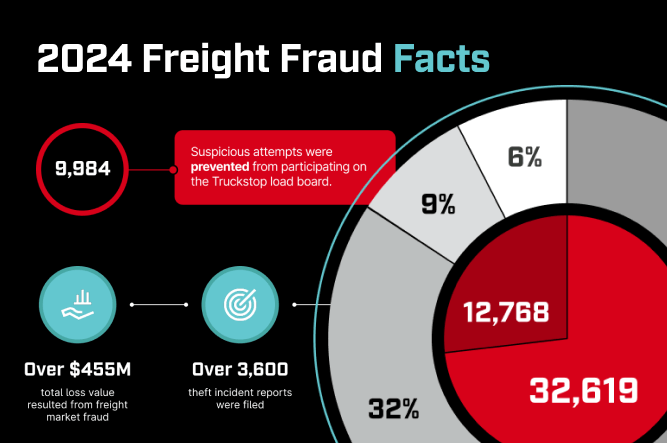Carrier Vetting & Fraud Prevention: How Smart Brokers Avoid Costly Mistakes
Freight brokerage is all about trust—shippers trust you to move their goods, and you trust carriers to deliver them safely. But what happens when that trust is broken?
Scams like double brokering, identity theft, and phantom carriers cost the industry hundreds of millions every year. And if you book a fraudulent trucker, you—not the shipper—could be left holding the bag for lost freight, unpaid claims, and damaged relationships.
The good news? With the right vetting process, you can spot red flags early and protect your business.
In this guide, we’ll cover:
✔ Why carrier fraud is skyrocketing
✔ The 5-step vetting process every broker should use
✔ Real-world scams (and how to avoid them)
✔ Tools that make fraud prevention easier
Let’s get into it.
Why Carrier Fraud Is Worse Than Ever
The freight industry has always had its share of scams, but three trends are making fraud more common and sophisticated:
1. The Rise of “Ghost Carriers”
Scammers create fake MC numbers, steal legitimate carrier identities, or pose as small fleets with clean records. By the time you realize they’re fraudulent, your load (and your money) is gone.
2. Double Brokering Schemes
A “carrier” books your load, then secretly re-brokers it to another trucker—often without insurance or proper authority. If something goes wrong, you’re still liable.
3. Fake Documentation
From photoshopped insurance certificates to doctored safety ratings, fraudsters are getting better at forging paperwork.
The 5-Step Carrier Vetting Process (That Actually Works)
You wouldn’t hire an employee without checking their resume, right? Treat carriers the same way. Here’s how:
Step 1: Verify FMCSA Authority
- Check the carrier’s MC number on the FMCSA SAFER System.
- Look for:
✅ Active status (not revoked or suspended)
✅ Correct operation type (must have “Motor Carrier” authority)
✅ No “red flag” alerts (like out-of-service orders)
❌ Red Flag: An MC number issued less than 30 days ago (common with scam operations).
Step 2: Confirm Insurance Coverage
- Don’t just take their word—call the insurance provider to verify:
- Policy is active
- Coverage meets your requirements ($1M+ auto liability is standard)
- Your brokerage is listed as a certificate holder
❌ Red Flag: A Gmail address on the insurance certificate (legitimate insurers use company domains).
Step 3: Check Safety & Inspection History
- Use FMCSA’s SMS (Safety Measurement System) to review:
- Crash history
- HOS (Hours of Service) violations
- Vehicle maintenance records
❌ Red Flag: A carrier with multiple “unsatisfactory” safety ratings.
Step 4: Research the Company Online
- Google the MC number – Scammers often reuse the same number across scams.
- Check reviews (Google, Truckstop, DAT) – Look for consistent complaints about non-payment or disappearing loads.
- Verify their physical address – A PO box or virtual office could mean no real operation.
❌ Red Flag: No online presence (legitimate carriers usually have some digital footprint).
Step 5: Require a Carrier Packet
Before booking a load, collect:
- W9 (for tax verification)
- Signed contract
- Driver’s license & truck registration (for the actual hauling truck)
❌ Red Flag: A carrier that refuses to send documents or uses excuses like “our system is down.”
3 Common Freight Scams (And How to Avoid Them)
1. The “Stolen Identity” Scam
How it works: Fraudsters pose as a real carrier using stolen MC and insurance details.
✅ Defense: Always call the insurance company directly (using a number from their website, not the document provided).
2. The “Disappearing Truck” Trick
How it works: A carrier picks up a load, then stops responding—sometimes reselling the freight.
✅ Defense: Use real-time GPS tracking (like Macropoint or TruckerTools) and require check-ins.
3. The “Quick-Pay” Bait
How it works: A new carrier offers cheap rates if you pay immediately after delivery—then vanishes with the money.
✅ Defense: Wait at least 48 hours to confirm the load was delivered properly before releasing payment.
Best Tools for Fraud Prevention
| Tool | What It Does |
|---|---|
| Carrier411 | Deep carrier background checks, fraud alerts |
| RMIS | Verifies insurance in real time |
| TIA Watchdog | Industry-wide scam carrier database |
| MyCarrierPackets | Automates document collection |
Final Tip: Trust, But Verify
The best brokers build relationships with reliable carriers—but they never skip vetting. One bad load with a fraudulent trucker can cost you thousands and ruin your reputation.
Take the extra time to check every carrier. Your customers (and your bottom line) will thank you.
What’s the wildest freight scam you’ve encountered? Share your stories below!

